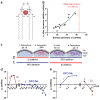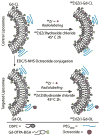(89)Zr-labeled paramagnetic octreotide-liposomes for PET-MR imaging of cancer
- PMID: 23224977
- PMCID: PMC3578092
- DOI: 10.1007/s11095-012-0929-8
(89)Zr-labeled paramagnetic octreotide-liposomes for PET-MR imaging of cancer
Abstract
Purpose: Dual-modality PET/MR platforms add a new dimension to patient diagnosis with high resolution, functional, and anatomical imaging. The full potential of this emerging hybrid modality could be realized by using a corresponding dual-modality probe. Here, we report pegylated liposome (LP) formulations, housing a MR T(1) contrast agent (Gd) and the positron-emitting (89)Zr (half-life: 3.27 days), for simultaneous PET and MR tumor imaging capabilities.
Methods: (89)Zr oxophilicity was unexpectedly found advantageous for direct radiolabeling of preformed paramagnetic LPs. LPs were conjugated with octreotide to selectively target neuroendocrine tumors via human somatostatin receptor subtype 2 (SSTr2). (89)Zr-Gd-LPs and octreotide-conjugated homolog were physically, chemically and biologically characterized.
Results: (89)Zr-LPs showed reasonable stability over serum proteins and chelator challenges for proof-of-concept in vitro and in vivo investigations. Nuclear and paramagnetic tracking quantified superior SSTr2-recognition of octreotide-LP compared to controls.
Conclusions: This study demonstrated SSTr2-targeting specificity along with direct chelator-free (89)Zr-labeling of LPs and dual PET/MR imaging properties.
Figures







References
-
- Bellin MF. MR contrast agents, the old and the new. Eur J Radiol. 2006;60(3):314–23. Epub 2006/09/29. - PubMed
-
- Shellock FG. MR imaging in patients with intraspinal bullets. J Magn Reson Imaging. 1999;10(1):107. Epub 1999/07/10. - PubMed
-
- Terreno E, Delli Castelli D, Cabella C, Dastru W, Sanino A, Stancanello J, et al. Paramagnetic liposomes as innovative contrast agents for magnetic resonance (MR) molecular imaging applications. Chem Biodivers. 2008;5(10):1901–12. Epub 2008/10/31. - PubMed
Publication types
MeSH terms
Substances
Grants and funding
LinkOut - more resources
Full Text Sources
Other Literature Sources

